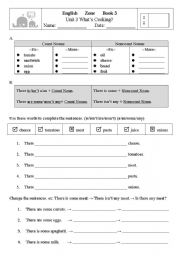
In questions we use a/ an, any or how many with countable nouns.Īnd we use any or how much with uncountable nouns.īut when we are offering something or asking for something, we normally use some. We use some with uncountable nouns in positive sentences and any with negatives.

Here are some examples of uncountable nouns: bread Countable nounsįor positive sentences we can use a/ an for singular nouns or some for plurals.įor negatives we can use a/ an for singular nouns or any for plurals. When you learn a new noun, you should check if it is countable or uncountable and note how it is used in a sentence. Uncountable nouns cannot be counted, e.g. Grammar test 1Ĭountable and uncountable nouns 1: Grammar test 1
Martin’s in 2009.Look at these examples to see how to use countable and uncountable nouns in a sentence. This information was retrieved directly from Chris Juzwiak’s Stepping Stones: A Guided Approach to Writing Sentences and Paragraphs, published by Bedford/St. Incorrect: An hard-working employee can be quickly promoted.Ĭorrect: A hard-working employee can be quickly promoted. Incorrect: A icy road can cause hazardous driving conditions.Ĭorrect: An icy road can cause hazardous driving conditions.
In article + adjective + noun combinations, use the article that fits the sound of the adjective, not the sound of the noun ( a for consonant sounds, an for vowel sounds). Incorrect: I always leave the beach with the sand in my bag.Ĭorrect: I always leave the beach with sand in my bag. Incorrect: The health is very important to Liz.Ĭorrect: Health is very important to Liz. Do not use the before noncount or plural nouns that mean “in general.”. The advice given to first-year students about avoiding procrastination can be very helpful. 
The information regarding her file was kept private. The professor provided feedback on the students’ book reports.
Use the to signal most specific nouns-both count and noncount. 
Incorrect: Robert gave Tina a jewelry for their anniversary.Ĭorrect: Robert gave Tina jewelry for their anniversary. Lily borrowed a cup of sugar from her new neighbors. (This is incorrect because sugar cannot be counted.)Ĭorrect: Lily borrowed sugar from her new neighbors. Incorrect: Lily borrowed a sugar from her new neighbors.
Do not use an article with noncount nouns. Use a or an to signal singular count nouns whose identity is not specified.Ī comes before words that begin with a consonant sound: b, c, d, f, g, j, k, l, m, n, p, q, r, s, t, v, w, x, z, usually h (as in words like harbor, hurt, and hand, when the h is heard), sometimes u (as in words like universe, unity, and university), and usually y.Īn comes before words that begin with a vowel sound: a, e, i, o, u, sometimes h (as in words like herb and hour, when the h is not really heard), and sometimes u (as in words like under, unlikely, and unseen).Ī university offers more classes than a community college.Īn hour seems like days in algebra class. Now that we better understand count and noncount nouns, we can take a look at rules for articles. Some examples of noncount nouns are: loyalty, information, pollution, salt, steel, etc. It is important to note that noncount nouns usually do not have plural forms (do not add – s or – es to the end of the words). Noncount nouns, on the other hand, refer to items, qualities, or concepts that cannot be counted. There are also two different kinds of nouns: count and noncount.Ĭount nouns refer to people, places, and things that can be counted.įor example, twenty students, eight rooms, one box, and four socks are all count nouns. Examples of nouns include: boys, women, Seattle, Virginia, paper, etc. Nouns are words that identify a person, place, or thing. To better understand how and when to use articles, it is important to understand nouns. For example, a, an, and the are the most commonly used articles. 
Articles are words that signal that a noun is coming up.








 0 kommentar(er)
0 kommentar(er)
